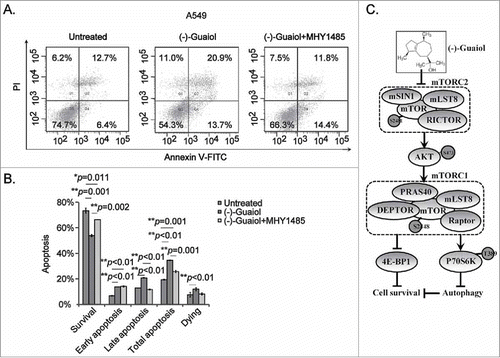Figures & data
Figure 1. (−)-Guaiol induces autophagy by inhibiting the mTORC2 activity in NSCLC cells. A-B. The total protein extracted from A549 (A) and H1299 (B) cells, treated with indicated concentrations of (−)-Guaiol, were subjected to western blotting analysis with indicated antibodies, using GAPDH as the internal control. The gray values of protein bands against GAPDH bands, automatically calculated using Image J software. Then the protein densitometry of (−)-Guaiol treated cells were normalized with that of untreated cells, which were recognized as relative protein level.
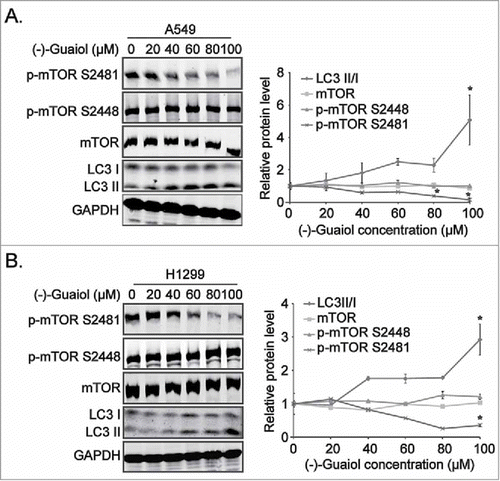
Figure 2. (−)-Guaiol targets the downstream effectors of mTORC2 in NSCLC cells. A-D. The whole protein extracted from A549 (A, C) and H1299 (B, D) cells, treated with indicated concentrations of (−)-Guaiol, were applied for western blotting analysis with indicated antibodies, using GAPDH as a loading control. The relative protein levels were defined as the gray values of protein bands against GAPDH bands, which were automatically calculated using Image J software. Then the protein densitometry of (−)-Guaiol treated cells were normalized to that of untreated cells, which were recognized as relative protein level.
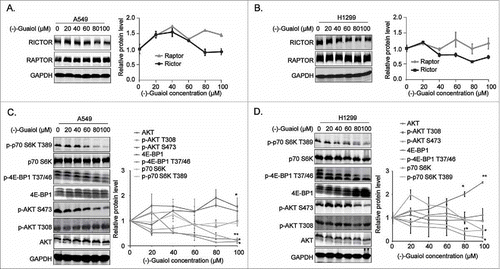
Figure 3. (−)-Guaiol induces autophagy by targeting mTOR pathways in NSCLC cells. A-B. Western blotting analysis of total protein from A549 (A) and H1299 (B) cells treated with or without (−)-Guaiol or (−)-Guaiol+MHY1485 in serum free medium for 24 h were conducted with indicated antibodies, taking GAPDH used as the internal control. The relative protein levels, which were used to statistical analysis, were calculated by normalizing the densitometry of treated cells to that of untreated cells.
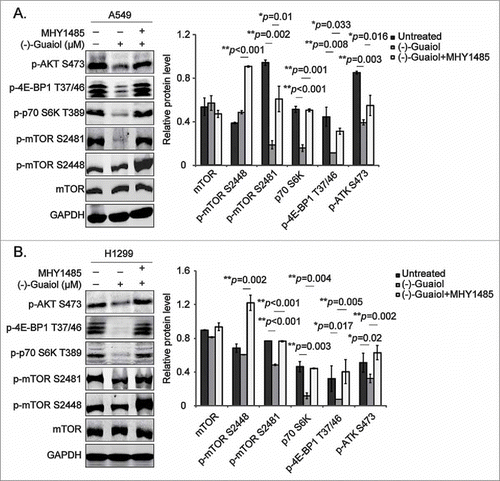
Figure 4. (−)-Guaiol targets mTOR signaling to inhibit cell survival in NSCLC cells. A. Cell survival assays of A549 and H1299 cells treated with or without (−)-Guaiol or (−)-Guaiol and MHY1485 were conducted to evaluate the role of (−)-Guaiol in tumor inhibition. The ANOVA test was applied to analyze the significance. B-C. Colony formation assays were performed to verify the function of (−)-Guaiol (B) or Rapamycin (C) in suppressing cell proliferation. The Image J software was used to automatically count the colonies at a size of 80-infinity. The ANOVA test was utilized to analyze the significance.
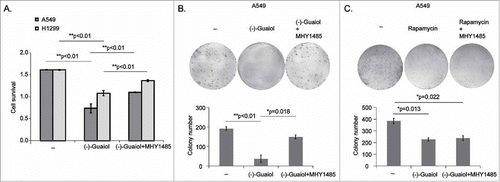
Figure 5. (−)-Guaiol targets mTOR signaling to promote cell apoptosis at late stage in NSCLC cells. A. Cell apoptosis was detected using flow cytometry analysis in A549 cells treated with or without (−)-Guaiol or (−)-Guaiol and MHY1485. B. The percentage of apoptotic cells (apoptosis %) from three independent tests were represented as mean ± STD and then statistically analyzed using ANOVA test. C. The schematic plot of the role of (−)-Guaiol in mTOR signaling pathway in NSCLC cells.
